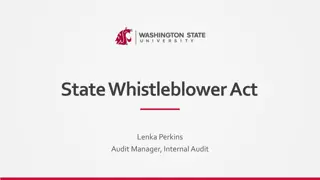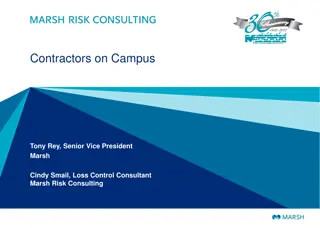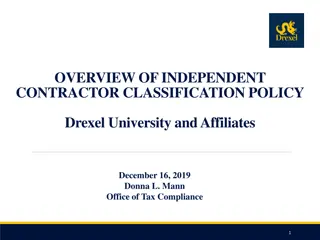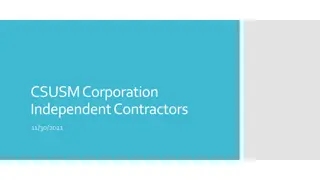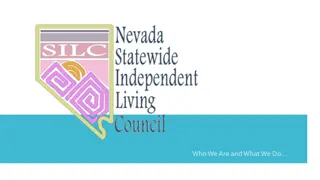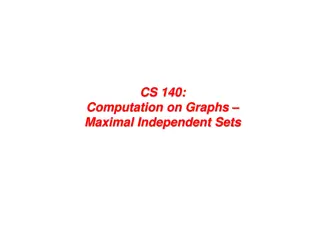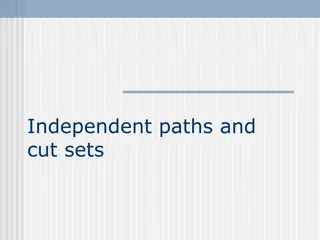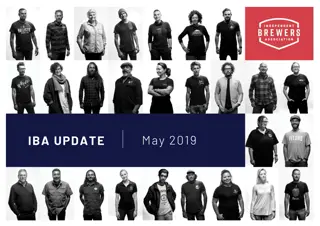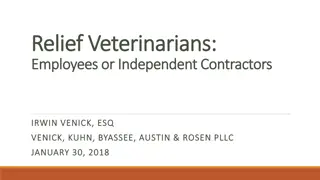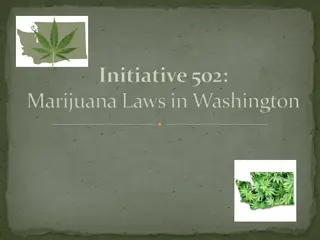Analysis of Independent Contractor Trends in Washington State
Explore the key findings and data sources related to independent contractor work in Washington State, including information on industry and occupation trends, preference for work arrangements, and self-employment statistics. The study delves into existing data gaps and provides insights into the self-employment landscape in the region.
Download Presentation

Please find below an Image/Link to download the presentation.
The content on the website is provided AS IS for your information and personal use only. It may not be sold, licensed, or shared on other websites without obtaining consent from the author.If you encounter any issues during the download, it is possible that the publisher has removed the file from their server.
You are allowed to download the files provided on this website for personal or commercial use, subject to the condition that they are used lawfully. All files are the property of their respective owners.
The content on the website is provided AS IS for your information and personal use only. It may not be sold, licensed, or shared on other websites without obtaining consent from the author.
E N D
Presentation Transcript
Independent Contractor Study Data Work Session Amber Siefer, MPA Project Manager September 28, 2018
Agenda Review and discuss: Existing data sources Recent findings Information gaps Feedback draft interim report
Federal Overview Source Name Description Notes Census CPS, ASEC, ACS, NES Unemployment and labor force participation; income, demographics, industry, occupation; Limited to non- incorporated self- employed; NES likely equates to more traditional ICs BLS CWS Contingent and alternative work arrangements IC s are largest of 4 groups; not secondary income; national only FRB SHED, EIWA National only IRS 1099(Misc or K), Schedule C, SE Non-employee compensation; third party online payments Washington counts only from 2000
Contingent Worker Survey, 2017 Key Findings (National) 10.6 million Independent Contractors (6.9%) More than 1 in 3 age 55+ More likely to be in traditional arrangements (management, business, finance) 79% prefer their work arrangement 3% were also contingent (lowest)
Self-employment, Washington Industry 2009 2016 Percentage Point Difference Agriculture, forestry, fishing, hunting, mining 14.2 10.2 -4 Construction 12.8 11.6 -1.2 Manufacturing 2.1 1.7 -0.4 Wholesale trade 4.3 3.3 -1 Retail trade 4.7 3.1 -1.6 Transportation and warehousing, and utilities 4.2 4.1 -0.1 Information 4.1 3.9 -0.2 Finance and insurance, and real estate and rental and leasing Professional, scientific, and management, and administrative and waste management services Educational services, and health care and social assistance Arts, entertainment, and recreation, and accommodation and food services Other services, except public administration 10 8.3 -1.7 12.8 11.9 -0.9 4.3 3.9 -0.4 5 4.6 -0.4 20.7 21.6 0.9 Public administration 0 0 0 State total 6.9 6.1 -0.8
Self-employment, Washington Occupation 2009 2016 Percentage Point Difference Management, professional and related 6.8 6 -0.9 Service 10 9.6 -0.4 Sales and office 5.4 4.2 -1.2 Farming, fishing, forestry (natural resources, construction, maintenance) Construction, extraction, maintenance, and repair Production, transportation, and material moving 4.9 9.5 4.1 3.7 -0.4 State total 6.9 6.1 -0.8
Katz & Krueger, 2016 Percent of Self-Employment Based on IRS Schedule C Filings and CPS Data, 1979-2014
Abraham, et al, 2018 Household Survey and Administrative Data Self-employment Rates, 1996-2016
Abraham, et al, 2018 Key Findings (National) 65% with self-employment income did not report to CPS Provides comprehensive work arrangement typologies Not one source alone can accurately measure the prevalence and evolution of self- employment over time
SHED and EIWA Surveys (FRB) More probing questions Age 30 (20%); Age 30-44 (15%); Age 45+ (11%) 36% adult US population engage in at least one informal work activity (child care, housecleaning, landscaping, selling or renting property, etc.) 65% indicated main reason was to earn extra money
Jackson, Looney, and Ramnath, 2017 Key Findings (2014 National): Increases in self-employment due to sole proprietors with little or no business-related deductions. Individuals who earned a significant share of their earnings from self-employment were less likely to be covered by health insurance or to participate in or make contributions to a retirement account. And more likely to purchase health insurance in the marketplace (13%, 3.5%)
Washington State 1099 data counts only Total Individuals who filed taxes that included a 1099 (Misc, K) 2000-2016 1,000,000 900,000 800,000 700,000 600,000 500,000 400,000 300,000 200,000 100,000 2000 2001 2002 2003 2004 2005 2006 2007 2008 2009 2010 2011 2012 2013 2014 2015 2016 1099 Misc 1099 K
Washington State 1099 data counts only Y-O-Y Change Total Individuals who filed taxes that included a 1099 (Misc, K) 8% 6% 4% 2% 0% 2001 2002 2003 2004 2005 2006 2007 2008 2009 2010 2011 2012 2013 2014 2015 2016 -2% -4% -6% -8%
State and Local Overview Source Name Description Notes DOR Business licenses; property tax records Active and inactive sole proprietorships; collection data from county assessors/treasurers Closest proxy to ICs; no income, expense or coverage data ESD Unemployment insurance wage file Employee only demographics, wages, and hours Self-employed workers can opt-in to new Paid Family and Medical Leave Program LNI Workers compensation, paid sick leave Employee only benefits Local TNC licenses Transportation Network Company-for hire drivers through online platforms Not easily accessible; variation based on local ordinances
Information gaps are large Independent Contractor Workers Supplemental ?% Primary 6.1% Intermittent Continuous Intermittent Continuous Coverage Coverage Benefits Benefits Participation Participation
Private Overview Source Name Description Notes The Freelancers Union Freelancing in America Survey Supplemental, temporary, project or contract based work Online by Edelman Intelligence since 2014 MBO Partners MBO Partners State of Independence Survey Number with independent arrangements, experiences and satisfaction Online by Emergent Research and Rockbridge Assoc. Pew Research Center Pew American Trends Panel Engagement in online work, motivations, demographics and public attitudes Online Pew panel JP Morgan Chase Institute JP Morgan Chase Institute Participation and earnings from 128 online platforms Bank account records survey
JPMC Institute, 2018 Key Findings (National): Online platform transformation over 5 years, increases in diversity of platforms but transportation sector is driving the growth in participation Average monthly earnings dropped 53% in transportation going from $1500 in 2013 to less than $800 in 2017 Median earnings are below $1,000 per month Most are active in just a few months of the year
Sources Abraham, et al 2018 http://www.nber.org/papers/w24950.pdf Jackson, Looney, and Ramnath, 2017 https://www.treasury.gov/resource-center/tax-policy/tax- analysis/Documents/WP-114.pdf Katz and Krueger, 2016 https://krueger.princeton.edu/sites/default/files/akrueger/files/katz_krueger_cws_- _march_29_20165.pdf SHED and EIWA https://www.federalreserve.gov/consumerscommunities/shed.htm; https://www.federalreserve.gov/consumerscommunities/eiwa.htm; https://www.federalreserve.gov/econresdata/feds/2016/files/2016089pap.pdf Private sources https://www.gigeconomydata.org/ Local sources http://mrsc.org/Home/Stay-Informed/MRSC-Insight/September- 2016/Regulating-Rideshare-Companies-Like-Uber-and-Lyft.aspx
Presented by: Amber Siefer Procurement Coordinator (360) 725-2733 amber.siefer@commerce.wa.gov www.commerce.wa.gov




